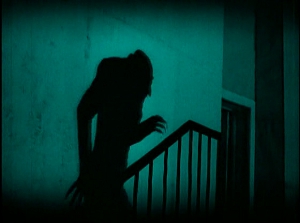
Here it is, then: Vampire Movie Zero. As far as anyone can tell, this is the first cinematic adaption of the Dracula and the film that popularized vampire mythos more than anything since Bram Stoker’s original novel. Studied by film students, poured over by professors, homaged by professionals and commentated upon by ninety years worth of talking heads…it’s too bad the damn thing’s so rarely seen. By people, I mean, out in the really-real world. If more people saw this, they might demand more from their vampire fiction, because they might realize how little its really moved, even after all this time.
If Stoker’s estate had anything to say about it, we would’ve never seen this film at all. Its producer and costume designer, Albin Grau, first heard a tall tale about a vampire from a Serbian farmer while serving on that front in 1916. After the war, he returned to Germany and founded the studio Prana Film for the express purpose of making a vampire movie. This one.
Problem: Stoker’s estate still owned the rights to Dracula, which had been adapted to the stage several times in the twenty-five years since its publication, but never filmed. (Again, as far as we know – something like half the films made in the Silent Era are officially lost to us.) Solution? Change everyone’s name (Mina became “Ellen,” Jonathan Harker became “Hutter,” Count Dracula became “Count Orlock”) and set the story in 1830s Germany. Surely, they thought, that will stave off the lawyers! It didn’t, and lawsuits followed, eventually bankrupting Prana Film and requiring all prints of Nosferatu be destroyed. Thankfully, that genie’d already escaped via several international distributors and several (often low-quality) nitrate stock copies. Continue reading Nosferatu: A Symphony of Horror (1922)
